|



VISITING
AUTHOR-ARTICLE
OCTOBER
2010

German
Products History Series
The
Bild
Lilli Doll Story
Forwarded
by Anonymus

The Bild Lilli Doll was a German
fashion doll produced from 1950 to 1964, based on
the comic-strip character Lilli. She is the
predecessor of Barbie.
 |
|
The
Bild Lilli Doll |

History
In the beginning Lilli was a German
cartoon character, created by Reinhard Beuthien for
the tabloid Bild-Zeitung
in Hamburg, Germany. In 1953 Bild-Zeitung decided to
market a Lilli doll and contacted Max Weissbrodt
from the toy company O&M
Hausser in Neustadt/Coburg, Germany. Following
Beuthien's drawings, Weissbrodt designed the
prototype of the doll, which was on sale from 1955
to 1964. When Mattel acquired the rights to the doll
the German production stopped. Until then production
numbers reached 130,000. Today Lilli is a
collector's piece as Barbie is, and commands prices
up to several thousand Euros, depending on
condition, packaging and clothes.
The
Cartoon
Reinhard Beuthien was ordered to make a
"filler" to conceal a blank space in the Bild-Zeitung
of June 24, 1952. He drew a cute baby, but his boss
didn't like it. So he kept the face, added a
ponytail and a curvy woman's body and called his
creation "Lilli". She sat in a
fortune-teller's tent asking: "Can't you tell
me the name and address of this rich and handsome
man?" The cartoon was an immediate success so
Beuthien had to draw new ones each day.
Lilli
was post-war, sassy and ambitious and had no
reservations talking about sex. As she had her own
job she earned her own money as a secretary but
wasn't above hanging out with rich men ("I
could do without balding old men but my budget
couldn't!"). The cartoon always consisted of a
picture of Lilli talking to girlfriends,
boyfriends, her boss ("As you were angry when I
was late this morning I will leave the office at
five p.m. sharp!"). The quips underneath the
cartoons handled topics ranging from fashion (to a
policeman who told her that two-piece-swimsuits are
banned: "Which piece do you want me to take
off?"), politics ("Of course I'm
interested in politics; no one should ignore the way
some politicians dress!") and even the beauty
of nature ("The sunrise is so beautiful that I
always stay late at the nightclub to see it!").
The last Lilli cartoon appeared on January 5,
1961.
The
Doll
Lilli
was available in these sizes 30 cm (12 inches)
and 19 cm (7 and a half inches). She held three
patents absolutely new in doll-making: The head
wasn't connected to the neck but ended at the chin;
the hair wasn't rooted but a cut-out scalp that was
attached by a hidden metal screw; the legs didn't
sprawl open when she was sitting. The doll was made
of plastic and had molded eyelashes, pale skin and a
painted face with side glancing eyes, high narrow
eyebrows and red lips. Her fingernails were painted
red, too. She wore her hair in a ponytail with one
curl kissing the forehead. Her shoes and earrings
were molded on. Her limbs were attached inside by
coated rubber bands. The cartoon Lilli was
blonde but a few of the dolls had other hair colors.
Each Lilli doll carried a miniature Bild-Zeitung
and was sold in a clear plastic tube.
In 1955 the tall dolls cost 12 Marks, the
small 7.50 Marks. German office workers then had a
monthly salary of approximately 200 to 300 Marks, so
the doll was by no means a cheap toy. She was
originally marketed to adults in bars and tobacco
shops as a joke or gag gift. Many parents considered
her not appropriate for children.
Although the doll was originally not designed
as a children's toy, she eventually became popular
with children. Doll
houses, room settings, furniture, and other toy
accessories to scale with the small Lilli were
produced by German toy factories to cash in on her
popularity amongst children and parents. Lilli and
her fashions were sold as children's toys in a
number of European countries, including Italy and
Scandinavian states. Lilli was as high-profiled and
successful as a toy as she was as an adult novelty,
although outside of Germany she is mostly remembered
in the latter guise.
The
Wardrobe
Lilli
came as a dressed doll, with additional fashions
sold separately. Her fashions mirror the lifestyle
of the Fifties: she had outfits for parties, the
beach and tennis as well as cotton dresses, pajamas
and poplin suits. In her last years, her wardrobe
consisted mainly of "Dirndl"
dresses.
Imitations
The doll became so popular that she was
exported to other countries, including the United
States, where she was just called "Lilli".
Some Lillis have been seen in original packaging
dating from the 1950s for an English-speaking market
labeled as "Lilli
Marlene", after the famous song. Several
toy companies (mainly in Hong Kong) started
producing fashion dolls looking very similar to Lilli.
These dolls are easy to distinguish because of their
poor quality.
But Lilli also inspired the production
of another fashion doll of high quality who would
soon outshine her: Barbie, produced by Mattel. Ruth
Handler, one of the company's founders, bought
some of the Lilli dolls when she was on a
trip to Europe. Back home she reworked the design of
the doll and re-named her Barbie, who debuted at the
New York toy fair on March 9, 1959. Barbie had
rooted hair and her shoes and earrings were not
molded — apart from that she was a lookalike of Lilli.
Barbie celebrated 50 years of continuous production
in 2009.
Louis Marx and Company acquired the rights to
the Lilli doll from O&M Hausser and released it
in America as the Miss Seventeen (doll) in
1961. Marx unsuccessfully attempted to sue Mattel
for patent infringement.
Related
Characters
In 1962 Beuthien created another cartoon
character called "Schwabinchen" for a
Bavarian newspaper but it wasn't as successful as Lilli
and the dolls inspired by her were in poor quality.
Later he started "Gigi" who had even less
success and never made it into a doll.
Lilli
became so popular in Germany that in 1958 a movie
about her was produced: "Lilli - ein Mädchen
aus der Großstadt" (Lilli — a girl from the
big city). The star was chosen from a contest: Young
women all over Germany sent their photographs to the
Bild-Zeitung
hoping for a career as a movie star. The winner was
the Danish actress Ann
Smyrner.
Lilli-boogie
Lyrics
Lilli
lent her name to several luxury products like scent,
wine and rhinestone jewelry plus a flower.
Further
Reading
There are no books about the Lilli doll
alone. Even though their whole Barbie success was
based on this German original, Mattel's legal
department made sure that using the name Bild Lilli
as a book title or product name would infringe
copyright laws. Mattel had discreetly bought up all
and any patents and copyrights to Bild Lilli, while
Marx Toys held some of them after the demise of this
toy competitor. Unlike Barbie, Bild Lilli was
produced for only eight years and never reached the
importance of the American doll. By the time the
creators and producers of the original Bild Lilli
doll, O&M
Hausser, realized that Mattel had duped them
into selling off their intellectual property and
distribution rights for ridiculously low lump sums,
Barbie had already made Mattel such a successful and
influential market leader that law suits were struck
down in favor of the ever-growing American toy
giant. However, in several books about Barbie or the
German lifestyle in the Fifties there are chapters
dedicated to Bild Lilli. In the book by Knaak all
dolls and wardrobes are described and shown in
color. More basic information can be found found in:
-
Knaak,
Silke: Deutsche Modepuppen der 50er und 60er
Jahre (German fashion dolls of the
Fifties and Sixties); 2005. No ISBN;
available at Barbies.de.
German and English.
-
Warnecke,
Dieter: Barbie im Wandel der Jahrzehnte;
Heyne 1995. ISBN
3-453-08738-0. German.
-
Metzger,
Wolfram (Ed.): 40 Jahre Barbie-World;
Info Verlag 1998. ISBN
3-88190-229-5. German.
-
Lord,
M.G.: Forever Barbie: The Unauthorized
Biography of a Real Doll; Avon Books 1995. ISBN
0-8027-7694-9. English.
-
Rolf
Hausser's Story
(Interview in the magazine "Barbie
Bazaar", February 2000). English.
-
Stephanie
Deutsch: Barbie. The First 30 Years 1959-1989.
Value guide.
http://en.wikipedia.org/wiki/Bild_Lilli_doll

|
BILD
LILLI DOLL EXAMPLES |
|
|
|
|
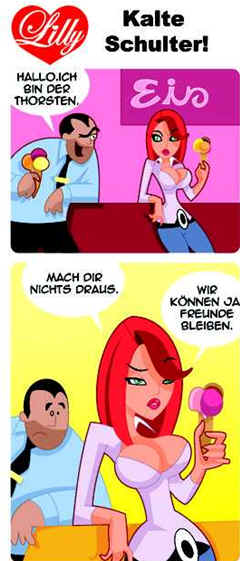 |
|
The
New Bild-Lilli
The German Bild
newspaper
recently revived the
Lilli cartoon series,
the new version of
Lilli is called Lilly:
|
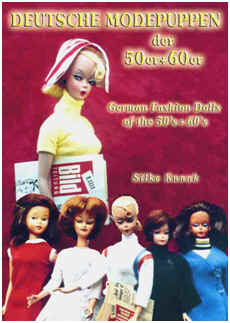 |
|
|

|
The Bild (formerly Bild-Zeitung
was founded by Axel
Springer in 1952. It
mostly consisted of pictures (therefore the
name BILD, German for picture).
Bild
soon became the best-selling newspaper, by a
wide margin, not only in Germany, but in all
of Europe, though essentially to German
readers.
Through
most of its history, Bild was based
in Hamburg. Bild moved its
headquarters to Berlin in March 2008,
stating that it was an essential base of
operations for a national newspaper. It is
printed nationwide with 32 localized
editions. Special editions are printed in
some favored German holiday destinations
abroad, in Spain, Italy, Greece and Turkey.
http://en.wikipedia.org/wiki/Bild-Zeitung |
|
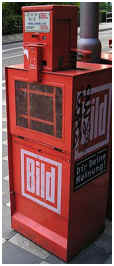
|
|
Bild
newspaper
vending
machine
in
Germany |
|

 |
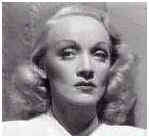 |
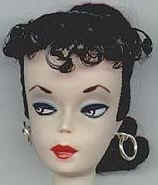 |
|
Bild
Lilli
1955-1960's |
Marlene
Dietrich, actress
(1901
- 1992) |
Doll
Reference |
|
|
Lilli was originally a cartoon
character created by German cartoonist
Reinhard Beuthien for a "filler"
on June 24, 1952 for the newspaper
Bild-Zeitung in Hamburg, Germany. She
became very popular as a curvy gal who knew
what she wanted and went about her business
to get it. She was classy, sassy,
fashionable (his wife Erika helped with the
fashions) and desirable, much like the Ms.
Dietrich of the 1930's movies .
After a short time Reinhard decided
to produce a doll of this character and it
was Max Weissbrodt from the famous Hausser/Elastolin
company in Neustadt/Coburg, Germany who
created and produced a doll to his
satisfaction.
On August 12, 1955 Lilli was first
sold in Germany, usually found in smoke
shops and a few toy stores. Later they
were exported to several countries, even the
USA (these have a doll stand with only
"Lilli" on them, the regular stand
says "Bild Lilli".
Lilli's original stand is just like
"younger-cousin" Barbie's it's
round and the dolls foot has holes that fit
on to a prong of metal. She was accompanied
by a miniature copy of the Hamburg newspaper
Bild-Zeitung and the cartoon continued to
run in the real journal every Sunday.
|
|
|
|
Her entire packaging was designed by
Mrs. E. Martha Maar (mother-in-law to the
owner of the Hausser company and owner of a
doll company 3 M Dolls), it consisted of a
clear oval tube with the doll on a Lilli
round stand as the bottom and a lid.
The doll is unmarked. Her stand
had her name on it.
She was produced in 7 1/2 -8"
and 11 1/2", her shoes and earrings are
molded on, she has a painted face with side
glancing eyes with white irises, high v-like
narrow eyebrows, red cupid bow lips and
fingernails. She is all plastic with
limbs attached inside by coated rubber
bands. Her hair is a cut-out scalp
that is attached by a hidden metal screw
that was not meant to be played with and is
in split curl bangs and a ponytail (Note:
this was intended for adult males as a party
or gag gift) usually found in Blonde. She
came as a dressed doll, with additional
fashions available separately. Her fashions
have push together snaps usually marked on
the inside snap with "PRMY".
She was also cloned and copied by other doll
makers .
This is the doll that Ruth Handler found
while shopping in Europe in 1956, and was
exactly what she had been thinking of
producing. She bought three dolls;
gave one to daughter Barbie and the others
to her designers at Mattel. The rest
is pretty well known history. Barbie
debuted at the New York toy fair on March 9,
1959. Mattel acquired the rights to
Lilli in 1964, thus her production ceased.
The Lilli head molds however were sold to a
British Hong Kong firm named Dura-Fam Ltd.
which produced the same 11 1/2" doll
which is found marked "Hong Kong".
Another set of molds were leased to Chang-Pi
Su Co. who reduced them to 7 1/2 - 8"
and released them as "Cherie".
More blank molds went to Fab-LU (Luften,
Ltd.) who sold a doll called Babs, Marx used
them too and had a doll called Bonnie, a
larger 15" doll called Miss Seventeen
"A Beauty Queen" and a 7"
doll named Miss Marlene. Sak
Industries, Inc. used the mold and
sold a doll named Babbie, and an Australian
firm Haro-Mate Ltd. sold the dolls marked
"Hong Kong" and carried the
registration number of "British Patent
#804566 and U.S. patent #2925684. Most of
these dolls come from the 1960's.
http://dollreference.com/bild_lilli.html |

|